 CLICK ON IMAGES FOR ADDITIONAL DETAILS CLICK ON IMAGES FOR ADDITIONAL DETAILS
unless accompanied by "not linked" icon.
|
| CARCHARHINIFORMES |
 |
 |
 |
 |
| SCYLIORHINIDAE |
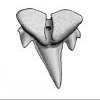 |
Scyliorhinus sp — Catsharks.
The small teeth from this genus are relatively common in Pungo River tailings. The illustrated tooth is 4.0 mm in height with longitudinal wrinkles on the labial face. Purdy et al (2001) include Scyliorhinus sp as a component of the Pungo River (units 1-5) and possibly Yorktown (unit 1 ?redeposit) faunas. |
| PROSCYLLIDAE |
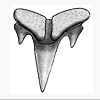 |
 ? Proscyllium sp — Gracile catshark.
? Proscyllium sp — Gracile catshark.
Less common than Scyliorhinus, these small Pungo teeth have a smooth labial crown face.
The adjoining specimen is 2.8 mm in height. This genus is currently represented by a single
extant species from the western Pacific. Not included by Purdy et al (2001). |
| TRIAKIDAE |
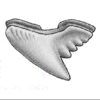 |
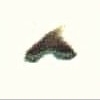 |
Galeorhinus aff galeus (LINNAEUS, 1758) (extant)
aka G. cf affinis (PROBST, 1878) (extinct) Tope shark.
Generally found in lower Yorktown sands and typically appear water worn. |
| |
Purdy et al (2001) ascribe these teeth to G. cf affinis and include them in Pungo
(units 1-5) and Yorktown (unit 1, ?redeposit) sediments. |
| |
Hypogaleus sp — Blacktip tope shark
The sole extant member of this genus H. hyugaensis (MIYOSI, 1939),
is known from western Pacific and Indian Ocean waters. Purdy et al (2001) reported a single Pungo (unit 1) specimen which compared well with the extant species. |
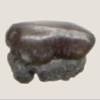 |
Mustelus sp — Smooth hound shark
Purdy et al (2001) had five specimens which compared well with the extant western Atlantic species M. canis (MITCHELL, 1815), They are atributed to the Pungo River (units 1-5) Formation. Accompanying image from Yorktown Unit 2. |
| HEMIGALEIDAE |
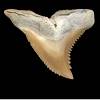 |
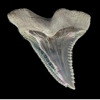 |
Hemipristis serra AGASSIZ, 1836
Extinct Snaggletooth shark
Abundant in YT & PR; H. elongata
(KLUNZINGER, 1871), Recent snaggletooth from western Pacific & Indian Oceans. Purdy et al (2001) included them in Pungo River (1-6) and Yorktown (1,2,?3). |
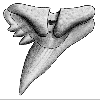 |
Paragaleus sp — Weasel shark
The accompanying Pungo tooth conforms well with a P. pectoralis (GARMAN, 1906) anterior
(extant, Atlantic Ocean) but not with the specimens imaged in Purdy et al (2001) which were attributed to Pungo
(units 1-5) and Yorktown (unit 1, ?reworked) which are more Carcharhinus sealei-like in design. |
|
| CARCHARHINIDAE |
| Carcharhinus species - Gray sharks
The teeth of this genus can drive a collector crazy and more than one opinion exists on what species contributed which teeth to the fossil record. Certain species are acknowledged by all, others are more controversial. |
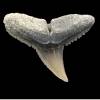 |
Carcharhinus brachyurus (GÜNTHER, 1870)
Copper shark
Abundant in the Pungo River, this genus is no longer represented in the Atlantic. Purdy et al (2001) note that Lee Creek teeth all have the female tooth-design (deemed by elasmo.com as not true). They reflect these teeth as being present in Pungo units 1-5. |
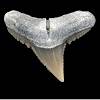 |
Carcharhinus falciformis (BIBRON, 1839)
Silky shark
Teeth from this species are common in the Pungo River. Purdy et al (2001) indicate that they were only able to positively identifiy upper teeth of this species.
They note their presence in Pungo units 2-4.
|
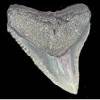 |
Carcharhinus cf galapagensis
(SNODGRASS & HELLER, 1905) Galapagos shark
A relatively rare tooth from the Yorktown and possibly the Pungo River.The accompanying upper lateral is 19 mm high. Purdy et al (2001) do not include this species in the fauna. |
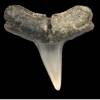 |
Carcharhinus cf isodon (VALENCIENNES, 1839)
Finetooth shark
Lower Pungo River tailings rarely yield these carcharhinid-like teeth with slender,
unserrated crowns. These teeth are similar to the extant species. Purdy et al (2001) do not include this tooth-design. |
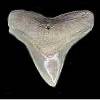 |
Carcharhinus leucas (VALENCIENNES, 1839)
— Bull shark. Common in the Yorktown, (smaller and less common in the Pungo River).
Purdy et al (2001) note this species as rare in the Pungo (units 1-5) and common in the Yorktown (units 1-3). They include C. longimanus-type teeth with leucas. |
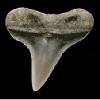 |
Carcharhinus cf limbatus (VALENCIENNES, 1839)
Blacktip shark.
An uncommon Pungo River species. Purdy et al (2001) do not include this species in the fauna. |
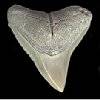 |
Carcharhinus cf longimanus (POEY, 1861)
Oceanic Whitetip shark
An uncommon tooth of the Yorktown and possibly the Pungo River formations. This upper lateral is 20 mm high. Purdy et al (2001) assign teeth of this design to C. leucas. |
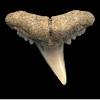 |
Carcharhinus cf macloti (MÜLLER & HENLE, 1839)
Hardnose shark.
Abundant in PR sands; the "cf" notation is required due to the sexual dimorphism displayed by this material.Today, it is found in the Indian Ocean and western Pacific. Purdy et al (2001) include these teeth in PR Units 1-5 & YT (unit 1, ?redeposit). |
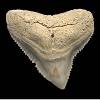 |
Carcharhinus obscurus (LeSUEUR, 1818)
— Dusky shark
This is the second Yorktown requiem which had large teeth. Purdy et al (2001) indicate they could only identify upper teeth with confidence. They note the presence of this tooth-design in Yorktown units 1-3. |
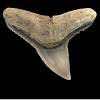 |
Carcharhinus perezii (POEY, 1876) — Caribbean Reef Shark
Purdy et al (2001) report teeth of this design from Pungo River units 3-5 and Yorktown Unit 1. The fifty specimens they assembled would suggest that the teeth are relatively common. |
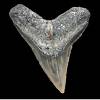 |
Carcharhinus plumbeus (Nardo, 1827)
— Sandbar shark
Uncommon in the Pungo & Yorktown, these teeth are notably thin with fine serrations. Purdy et al (2001) report teeth of this design from the Pungo River (units 4 & 5) and the Yorktown (Unit 1). |
| . |
Tiger Sharks
For years. the identification of Lee Creek tiger sharks was pretty straight forward. There was contortus, aduncus and cuvier with the occasional vote for mayumbensis. In 2001 however, the waters began to muddy. First, Purdy et al elected not to use aduncus, calling these teeth Galeocerdo sp. Those author's also disagreed as to whether cuvier teeth should go by that name or possibly G. capellini, they settled on G. cf cuvier. Only G. contortus survived unscathed but not for long. Later that year, Ward & Bonavia published their Malta paper. In it, they reassigned aduncus to Physogaleus and synonymized contortus with aduncus!
Contortus had struck me as Physogaleus for years, so that wasn't much of a leap. Aduncus is a bit trickier. Eocene sediments that produce Physogaleus secundus teeth, occasionally yield aduncus-like specimens, but not nearly as serrate or in such relative abundance. However the similarity between aduncus and cuvier teeth is so striking that it's hard to ignore, and as Bill Heim notes, if aduncus is Physogaleus, that leaves Lee Creek without a Miocene tiger shark. An unaddressed possibility does exist — a convergence of lateral tooth-designs between two genera.
The below identifications are a wishy-washy way of expressing these conflicting opinions. Hopefully it won't take too long before these waters clear.
|
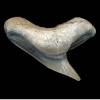 |
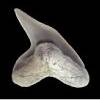 |
Physogaleus "contortus" | aka Galeocerdo contortus GIBBES, 1849 | aka Physogaleus aduncus (AGASSIZ, 1843) — extinct genus
Very abundant in the Pungo River tailings and best characterized by a twisted crown and robust root. |
| Purdy et al (2001) attribute to Pungo Units 1-6 and distinguish them from "aduncas". |
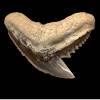 |
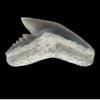 |
Galeocerdo aduncus (AGASSIZ, 1843) |
Physogaleus aduncus |
Galeocerdo sp
— extinct Tiger shark.
An abundant tiger shark found in Pungo River tailings usually associated with contortus; root less robust and cusp not twisted. |
| Purdy et al (2001) reject using aduncas as the species in favor of Galeocerdo sp. They cite the loss of Agassiz's holotype and the uncertain stratigraphic position the specimen. They note that these teeth are present in the Pungo units 1-6. |
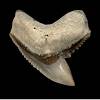 |
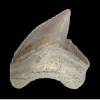 |
Galeocerdo cuvier (PERON & LeSUEUR, 1822) — Tiger shark.
Common in the Yorktown (units 1-3). Purdy et al (2001) reflect the disagreement of the authors on the identity of these teeth by settling on G. cf cuvier. |
| Based on the straightness of the mesial cutting edge, G. capellini LAWLEY, 1876 from the Pliocene of Italy was considered. G. rosaliaensis APPELGATE, 1958 from Baja was also considered but synonymized with capellini. |
| |
Galeocerdo mayumbensis
(DARTEVELLE & CASIER, 1943) — extinct Tiger shark.
Advocates point to features of the tooth which are different from G. cuvier and
suggest that they represent a more southerly species occassionally appearing in the Lee
Creek area. Richard Chandler addressed this topic, see
Galeocerdo cuvier Lineage. Others consider this odontological design to be within a range of variation valid for G. cuvier. |
| . |
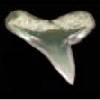 |
cf Loxodon sp — Sliteye Shark
Imaged tooth from Pungo River sediments, specimen is 9.0 mm slant height.
Purdy et al (2001) did not include this design in their paper. |
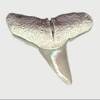 |
Negaprion eurybathrodon (BLAKE, 1862)
?extinct Lemon shark
Purdy et al (2001) believe these teeth to belong to
N. eurybathrodon and that N. brevirostris
(POEY, 1868), an extant taxa, may be a junior synonym.They report
them from the Yorktown (1 & 2) and a single tooth from the Pungo (unit 4/5). |
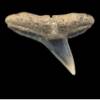 |
Rhizoprionodon sp
— Sharpnose shark
Similar to R. fischeuri (JOLEAUD, 1862) & moderately common in the Pungo River (1-5). Noting them as similar to the extant Western Atlantic species, R. terraenovae (RICHARDSON, 1836), Purdy et al (2001) list as Rhizoprionodon? due to the similarities with Loxodon, Scoliodon and some Sphyrna. |
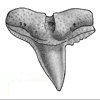 |
cf Rhizoprionodon acutus (RÜPPELL, 1837)
— Milk shark
The author is currently the only proponent of this identification. The basal Yorktown produces shark teeth uncommon or not found in the Pungo River. A number of these teeth compare very well with this extant species. Purdy et al (2001) did not include these teeth in their paper. |
 |
Triaenodon sp — Whitetip reef shark

Purdy et al (2001) included Triaenodon
in the Pungo River (units 1-3) fauna. This website includes this tooth design as
Carcharoides catticus. |
|
SPHYRNIDAE |
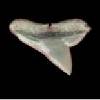 |
Sphyrna lewini (GRIFFITH & SMITH, 1834)
Scalloped Hammerhead
Heim notes these as being the smaller Pungo River
hammerhead teeth, accompanying specimen has a 10.0 mm slant height. Purdy et al (2001)
include their four specimens as being from the Yorktown's unit 3. |
| |
Sphyrna media SPRINGER, 1940
— Scoophead shark
Purdy et al (2001) note this species teeth in
the Pungo River (units 1-5) and Yorktown (units 1 & 2). |
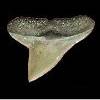 |
Sphyrna zygaena (LINNAEUS, 1758)
— Smooth Hammerhead
A common hammerhead found in Pungo River tailings.
The accompanying image has a 16mm (slant) height. Purdy et al (2001) include these
teeth in the Pungo's units 1-5 and Yorktown's units 1-3. They synonymized
S. laevissimus COPE, 1867 with S. zygaena. The
authors also noted that Yorktown specimens were larger and more serrate than their
Pungo counterparts. |